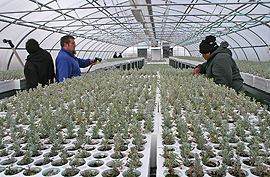In 2005, the Bureau of Land Management in Idaho formed a multiyear partnership with
two tribes to develop native-plant materials for fire-restoration and
fire-rehabilitation projects. BLM secured funding for its agreement with the
Shoshone-Bannock and the Shoshone-Paiute tribes through the Native Plants
Material Program, an
interagency program that is part of the National Fire Plan. In place
within BLM since 2000, NPMP meets Congress’ direction to “supply
native plant material for emergency stabilization and longer term
rehabilitation and restoration efforts.”
Idaho is
part of BLM’s Great Basin Restoration Initiative, research efforts to reverse ecological damages in the the
arid region. Like others in the region, BLM managers in Idaho are faced with increased wildfires due to invasive weeds, as
well as the resultant rehabilitation work. In support of the initiative, they have strived to
integrate native-plant materials into all projects involving restoration, fuels
management, emergency stabilization and rehabilitation of burned areas. Through
its partnerships with area
tribes, Idaho BLM has developed a ready source of native-plant materials. Using NPMP funds, Idaho BLM and the tribes have
cooperatively built a greenhouse on each reservation so tribes can grow and
supply it with native seedlings. The greenhouses, which are located near
schools, also give students from the tribes the opportunity to manage them and
to produce plant material. With
subsequent funding, technical assistance and their partnership with BLM, the tribes’
hard work has met
with success: The Shoshone-Bannock tribe has planted and grown 40,000 sagebrush
seedlings, and the Shoshone-Paiute tribe is growing 60,000 bitterbrush and
sagebrush seedlings. In turn, BLM’s Idaho Falls and Twin
Falls Districts purchased all of the seedlings for use in fire rehabilitation
during March 2008. “It’s all moving along well with help from employees of the
BLM,” said Hunter Osborne, the greenhouse manager for the Shoshone Bannock tribe.
“They have been instrumental in the success of the program. We are busy getting the nurseries ready for
the next season and recently received funding to build another nursery.” The Shoshone-Bannock tribe also provided resources to build
a refrigeration unit to store the seedlings once they are ready. Refrigeration will allow the tribe to replant
and conduct “grow” operations year round.
If the tribe is able to produce more seedlings, Idaho BLM will purchase
the additional plant material. Alternatively, it may refer its federal and
state partners to the tribes so they may purchase the seedlings. The partnership has also allowed Idaho BLM to reach out to
several federal partners to assist the tribes in expanding opportunities for
native-plant production by getting into native-seed collection. USDA Forest Service offices (Lucky Peak Nursery and its Research
Lab in Boise, Idaho,
and Provo, Utah) have been training the tribes on production-and-collection
aspects of native plants/seeds. Lucky
Peak committed to assist
the tribes in
cleaning seed and germination testing.
The Research Lab provided training on the reservations about identification,
collection and federal requirements for purchase and use. The Natural Resource Conservation Service
provides technical expertise, as needed, on the Shoshone-Bannock tribe’s Fort Hall Reservation. In the future, the tribes are interested in expanding their
partnership with BLM to provide greater quantity and variety of native-plant
material (seeds and seedlings). They
are also interested in employment and educational opportunities this could
generate. These could include training and employment through the Youth
Conservation Corps and training in business, botany, natural resources, and
fire management. It could also involve employing adult crews for seed
gathering, planting, grow operations, as well as expanding the greenhouse
and/or moving into outdoor-nursery operations.
Idaho BLM hopes to continue to work cooperatively with both
tribes to enhance the availability of native-plant material for use on public lands throughout future years.
Contents
Bureau News
More About Interior



 Print Version
Print Version
 E-mail This Article
E-mail This Article
